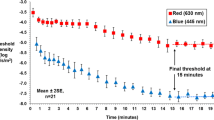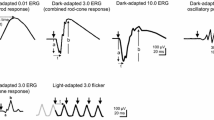Abstract
Purpose
To determine the electroretinographical and psychophysical parameters that can help to verify patients’ complaints of reduced night vision.
Methods
We tested 275 consecutive patients with normal appearing fundi, complaining of visual difficulties at night, using flash electroretinography (ERG) and dark adaptation (DA) test. Two ERG parameters were used to assess a scotopic retinal function: the amplitude of the response to dim blue flash (the rod response) and the b-wave ratio (measured/expected). Dark adaptation was measured with green- and red-light stimuli after exposure to a bright, bleaching light. The psychophysical parameter of night vision was defined as the threshold for detection of the blue-green stimulus that was measured after 40–45 min in complete darkness.
Results
Fifty-five patients were excluded from the analysis because of a discrepancy between the two ERG parameters in assessment of scotopic retinal function. The remaining 220 patients were divided into 4 groups: (1) normal ERG and normal DA, (2) subnormal ERG and subnormal DA, (3) normal ERG and subnormal DA and (4) subnormal ERG and normal DA. The ERG and DA tests supported the complaint of visual difficulties at night in 67 patients (group 2), while 34 patients were characterized as having normal scotopic visual function (group 1). The other 119 patients (groups 3 and 4) presented a diagnostic dilemma because one test (ERG or dark adaptation) showed normal scotopic function, while the other indicated subnormal scotopic function.
Conclusion
Our findings indicate that ERG is an essential, but not sufficient test for verifying patient’s complaint on visual difficulties in the dark. We suggest using both electroretinography and psychophysical dark adaptation to test patients complaining of reduced night vision.






Similar content being viewed by others
References
Dryja TP (2000) Molecular genetics of Oguchi disease fundus albipunctatus, and other forms of stationary night blindness: LVII Edward Jackson Memorial Lecture. Am J Ophthalmol 130:547–563
Audo I, Robson AG, Holder GE, Moore AT (2008) The negative ERG: clinical phenotypes and disease mechanisms of inner retinal dysfunction. Surv Ophthalmol 53:16–40
Zeitz C, Robson AG, Audo I (2015) Congenital stationary night blindness: an analysis and update of genotype-phenotype correlations and pathogenic mechanisms. Prog Retinal Eye Res 45:58–110
Miyake Y, Yagasaki K, Horiguchi M, Kawase Y, Kanda T (1986) Congenital stationary night blindness with negative electroretinogram. A new classification. Arch Ophthalmol 104:1013–1020
Sergouniotis PI, Robson SG, Li Z, Devery S, Holder GE, Moore AT, Webster AR (2012) A phenotype study of congenital stationary night blindness (CSNB) associated with mutations in the GRM6 gene. Acta Ophthalmol 90:e192–e197
Perlman I, Barzilai D, Haim T, Schramek A (1983) Night vision in a case of vitamin A deficiency due to malabsorption. Br J Ophthalmol 67:37–42
Berson EL, Lessell S (1988) Paraneoplastic night blindness with malignant melanoma. Am J Ophthalmol 106:307–311
Lei B, Bush RA, Milam AH et al (2000) Human melanoma-associated retinopathy (MAR) antibodies alter the retinal ON-response of the monkey ERG in vivo. Invest Ophthalmol Vis Sci 41:262–266
Perlman I (1983) Relationship between the amplitudes of the b wave and the a wave as a useful index for evaluating the electroretinogram. Br J Ophthalmol 67:443–448
Hecht S, Haig C, Chase AM (1937) The influence of light adaptation on subsequent dark adaptation of the eye. J Gen Physiol 20:831–850
Pugh EN Jr (1975) Rushton’s paradox: rod dark adaptation after fash photolysis. J Physiol 248:413–431
Riggs LA (1954) Electroretinography in cases of night blindness. Am J Ophthalmol 38:70–78
Auerbach E, Godel V, Rowe H (1954) An electrophysiological and psychophysical study of two forms of congenital night blindness. Invest Ophthalmol 8:332–345
Marmor MF, Zeitz C (2018) Riggs-type dominant congenital stationary night blindness: ERG findings, a new GNAT1 mutation and a systemic association. Doc Ophthalmol 137:57–62
Khan NW, Kondo M, Hiriyanna KT, Jamison JA, Bush RA, Sievng PA (2005) Primate retinal signalling pathways: suppressing ON-pathway activity in monkey with glutamate analogues mimics human CSNB1-NYX genetic night blindness. J Neurophysiol 93:481–492
Oh A, Loew ER, Foster ML et al (2018) Phenotypic characterization of complete CSNB in the inbred research beagle: how common is CSNB in research and companion dogs? Doc Ophthalmol 137:87–101
Slaughter MM, Miller RF (1981) 2-amini-4-phosphonobutyric acid: a mew pharmacological tool for retina research. Science 211:182–185
Stockton RA, Slaughter MM (1989) B-wave of the electroretinogram. A reflection of ON bipolar cell activity. J Gen Physiol 93:101–122
Sieving PA, Murayama K, Naareddrop F (1994) Push-pull model of the primate photopic electroretinogram: a role for hyperpolarizing neurons in shaping the b-wave. Vis Neurosci 11:519–532
Rodieck RW (1973) The vertebrate retina: principles of structure and function. W.H. Freeman, San Francisco
Perlman I (1995) The electroretinogram: ERG. In: Kolb H, Fernandez E, Nelson R (eds) Webvision: the organization of the retina and visual system. University of Utah Health Sciences Center, Salt Lake City
Fitzgerald KM, Cibis GW, Giambrone SA, Harriz DJ (1994) Retinal signal transmission in duchenne muscular dystrophy: evidence for dysfunction in the photoreceptor/depolarizing bipolar cell pathwy. J Clin Invest 93:2425–2430
Tremblay F, De Becker I, Riddell DC, Dooley JM (1994) Duchenne muscular dystrophy: negative scotopic bright-flash electroretinogram and normal dark adaptation. Can J Ophthalmol 29:280–283
Jensen H, Warburg M, Sjo O, Schwartz M (1995) Duchenne muscular dystrophy: negative electroretinogram and normal dark adaptation. Reappraisal of assignment of X linked incomplete congenital stationary night blindness. J Med Genet 32:348–351
Fitzgerald KM, Hashimoto T, Hug TE, Cibis GW, Harris DJ (2001) Autosomal dominant inheritance of a negative electroretinogram phenotype in three generations. Am J Ophthalmol 131:495–502
Sobaci G, Erdem U, Uysal Y, Gundogan FC, Bayraktar MZ (2007) Negative electroretinogram in the differential diagnosis of malingering of night blindness in the military. Mil Med 172:402–404
Asi H, Perlman I (1992) Relationship between the electroretinogram a-wave, b-wave and oscillatory potentials and their application to clinical diagnosis. Doc Ophthalmol 79:125–139
Funding
No funding was received for this work.
Author information
Authors and Affiliations
Corresponding author
Ethics declarations
Conflict of interest
The authors declare that they have no conflict of interest.
Ethical approval
All procedures performed in studies involving human participants were in accordance with the ethical standards of the institutional committee and with the 1964 Helsinki declaration and its later amendments or comparable ethical standards.
Informed consent
For this type of study, formal consent is not required.
Additional information
Publisher's Note
Springer Nature remains neutral with regard to jurisdictional claims in published maps and institutional affiliations.
Rights and permissions
About this article
Cite this article
Allon, G., Friedrich, Y., Mezer, E. et al. Verifying complaints of difficulties in night vision using electroretinography and dark adaptation tests. Doc Ophthalmol 140, 169–180 (2020). https://doi.org/10.1007/s10633-019-09729-z
Received:
Accepted:
Published:
Issue Date:
DOI: https://doi.org/10.1007/s10633-019-09729-z




